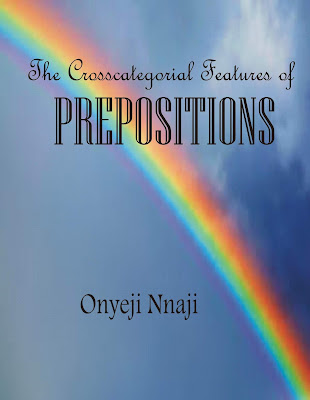Social Media Languages and their Influences on Modern Languages - Onyeji Nnaji
Language is the basic communication system that allows users to express their thoughts, feelings and pass pieces of information across persons. As a system of communication, language explores various means to make itself intelligible. Language can occur as a system of signs, it could be verbal; it could also be iconic. Whichever system a particular language applies is richly dependent on the dominant population of people occupying such a language setting. This is because the medium of use for a language determines the language in use. By this condition also, medium determines the words, phrases and possibly the symbols used by any language community. This is the reason why social media addopt their own language which is currently influencing several other language communities.
Social media language is the communication system people use to express themselves on the Internet, particularly on discussion platforms. When the Internet just appeared, its users kept speaking as they did in real life, but with time, this practice evolved. A whole new kind of vocabulary appeared, along with its unique fancy, punctuation, and symbols. Since English dominates social media, it sets norms and trends in this sphere, and many of them have affected the English language itself to a huge extent
The use of social media languages appears to have made English easier. Accuracy of grammatical terms is not explicit in this usage, but the knowledge of the semantic compositions does not pose problem to those using the language. What is prominent here is the freehanded voicing of ideas which quickly create understanding of the communicated information without regards to the conditions of tense agreement or the accurate prepositions to use. Social media language appears formal only when it is used to express abbreviations and some professional terms. It also dishonours words 's inflections for both genitives and numbers.
With the huge influence of language generally, social media appears to have changed communication in varying ways. It removed the stressful aspect of fluency and replaced it with easy and speedy communications, thereby allowing online users the freedom to make fun upon words during interaction among communication pals. These days, people focus on content, not on the way it is presented. Proper paragraphing is no longer adhered to, instead, overall coherency is all that matters for one's communication to thrive. These same effects can be viewed in a more negative light too. This is the kind of situation George Orwell described as "Killing the Elephant". In his view,
"Modern writing at its worst does not consist in picking out words for the sake of their meaning and inventing images in order to make the meaning clearer. It consists in gumming together long strips of words which have already been set in order by someone else, and making the result presentable by sheer humbug," Strand, 53).
The huge impact this has on learners (especially learners of the English language) is that it is increasingly difficult to find people who can write fluently because of the bulk of the social media vocabularies in their brain. Students start facing an increasing number of problems in schools and colleges for not being able to complete their assignments properly. The reason for it is obvious: most people, especially the youth, do most of their writing online. Students getting used to constant misspellings, use of abbreviations, contractions, and informal words are extremely commonplace on forums and discussion platforms. With students being used to all these, social media surely will affect their writing skills, and the results are frustrating, both for students and their lecturers.
Misuse of words and usage of slurs that many online users don’t recognize as offensive are other ways social media language affects language learners. Internet is gaining volume by the day; as people from all walks of life start interacting with each other, including individuals of different races, sexualities, religions, and so on. On the one hand, it’s great, but on the other, they interact by using social media vocabularies that they do not always understand their semantic implications. Only few of them may bother to look up the word’s meaning. Racist slurs and homophobic expressions began to flourish newly simply because it is too difficult to understand language nuances when one does not hear a person’s tone or understand the context fully.
WHY SOCIAL MEDIA LANGUAGE IS USED IN MODREN LANGUAGE:
The reason why social linguistics is dominating the language space presently is because, the internet has become the dwelling place for the present generation. And being so connected to the use of the internet on dailies, the acculturation becomes inevitable. Internet language affects our everyday communications. Some terminologies we use online come to play in verbal conversations. Phrases like “Google something,” “she unfriended me,” “he’s a troll,” “it’s a new buzzword,” “lmao” and others start sounding left and right. Lesser strictness of grammar follows the same attitude as people freely omit some words when they are talking. This creates certain generational gap amidst those who do mot use social media as often and those who do often visit the internet. With this, those who do not use the internet frequently, especially older generation, begin to lose the ability to follow some conversations. Many of them admit that listening to modern teenagers is like listening to foreigners who speak another language.
Like written forms of communication, verbal communication is also acculturated into this online language communicating system. This is because, the society needs a language to communicate fluently, and the very language readily preferred for use in any society is usually that language that reaches out to the greater population the same becomes the language of commerce and other social lifestyle obtainable within such a society. And since social media language had appeared to dominate the modern society, it becomes very important that odern language should incorporate it.
Currently, several social media vocabularies have been wedded into modern language, many of which are acronyms, abbreviations and phrases. Some of them include the followings;
* ITk: this is used to address inquisitiveness. it means "I too know".
* Mash-up. When people make edits or collages from the existing content, combining different characters or events into one composition, it’s called a mash-up.
* Hater. These are people who try to drown everyone in toxicity. For example, you found the best Korean translation services and decided to leave your review, but when you accessed some neutral platform, you saw someone spamming it with intense negativity, pouring dirt on the company, and describing things that are the opposite of what you yourself experienced. Negative comments are natural, but overblown hostility makes one a hater.
* DM me. ‘DM’ stands for ‘direct message’. So, if someone asks you to DM them, it basically means, “Send me a private message.” This example underlines changes in English language over time in terms of abbreviations and grammar.
* AMA. ‘Ask Me Anything’ sessions take place on platforms like Reddit and Tumblr. A person who interests the public sets a date when they’ll be answering different questions. For instance, many people had questions for James Kolar, the author of ‘Foreign Faction’ book written about JonBenét Ramsey case. He organized AMA on one of Reddit subs, giving long-awaited answers that triggered people’s interest in the crime. Others are shorty stated below.
IDK: "I don't know"
IKR: "I know, right?"
IRL: "In real life"
ICYMI: "In case you missed it"
FYI: "For your information"
AMA: "Ask me anything"
LOL: "Laughing out loud"
TBF: "To be fair"
TBH: "To be honest"
LOL: "Laughing out loud"
TFW: "That feeling when"
FOMO: "Fear of missing out"
LMK: "Let me know"
OMW: "On my way"
BTW: "By the way"
DM: "Direct message"
FYI: "For your information"
FF: "Follow Friday"
B2B: "Business-to-business"
B2C: "Business-to-consumer"
CMS: "Content management system"
CTR: "Click-through rate"
CVR: "Conversion rate"
CPM: "Cost per mille"
CTA: "Call to action"
SMO: "Social media optimization"
KPI: "Key performance indicator"
UGC: "User-generated content"
SEO: "Search engine optimization"
RSS: "Rich Site Summary"
One prominent reason for the outpouring of social media language into the modern language is that pervasive influence of social media platforms on daily communication and cultural trends. Social media language, often characterized by abbreviations, slang, and digital expressions, reflects the fast-paced and informal nature of online interactions. This linguistic influence is also driven by the desire for inclusivity, belonging, and the ability to connect with specific online communities. Some of the reasons are stated below:
1. Pervasive Influence of Social Media:
Ubiquitous Use:
Social media has become a dominant force in daily communication, with people spending significant time engaging on platforms like Facebook, Twitter, Instagram, and TikTok.
Informal Communication:
These platforms often encourage informal and casual language, leading to the adoption of abbreviations, slang, and emojis.
Cultural Impact:
Social media trends and language patterns quickly spread and influence broader language use, as people adopt and adapt to online communication norms.
2. Communication Efficiency:
Conciseness:
Social media often favors concise communication due to character limits and the desire for quick engagement.
Abbreviations and Slang:
These tools help users express themselves efficiently and convey meaning quickly.
Emojis and Visuals:
Digital expressions and visuals enhance communication and add layers of meaning to online interactions.
3. Social Identity and Belonging:
In-group Language:
Social media language can be used to signal membership within specific online communities or groups, according to research.
Shared Understanding:
Utilizing specific language helps users connect and build a sense of shared identity within online communities.
Fluidity and Adaptability:
Language evolves and adapts within specific online contexts, fostering creativity and experimentation.
4. Linguistic Innovation and Change:
New Words and Phrases:
Social media can introduce new words, phrases, and linguistic structures that then diffuse into broader language use.
CONCLUSION;
Language is a tool, not only used for communication, but also for analysis and experimentation. Occasionally, Language users play with the language in their possession. Online communication allows users to experiment with language in unique and creative ways. With such freedom of usage, many cultural tools have been weaved into online language to reflect modern Language. This situation had been Interpreted by many as a relection of Cultural Shifts: e adoption of social media language reflects broader cultural shifts and changing of communication norms.
Reference
Alexander, B. (2006). Web 2.0: A New Wave of Innovation for Teaching and Learning? EDUCAUSE Review. 41(2). 32-44. Accessed: http://www.educause.edu/ero/article/web-20-new-wave-innovation-teaching-and-learning
Alexander, B. (2008) “Web 2.0 and Emergent Multiliteracies.” Theory Into Practice. 47(2), 150-60. Retrieved from http://dx.doi.org/10.1080/00405840801992371
Armstrong, K. & Retterer, O. (2008). Blogging as L2 Writing: A case study. AACE Journal, 16(3), 233-251. Retrieved from http://www.editlib.org.ezproxy.library.ubc.ca/p/24300
Barnes, S. B. (2008). “Understanding social media from the media ecological perspective.” In Mediated Interpersonal Communication Eds. Elly Konijn, Inc NetLibrary, Elly Konijn. Boston: Routledge.
Baron, N. (2009). Are Digital Media Changing Language? Literacy 2.0. 66(6). 42-46.
Bolter, J. D. (2001). Writing space: Computers, hypertext, and the remediation of print. Routledge.
boyd, d. (2007) “Why Youth (Heart)Social Network Sites: The Role of Networked Publics in Teenage Social Life.” MacArthur Foundation Series on Digital Learning –Youth, Identity, and Digital Media Volume (ed. David Buckingham). Cambridge, MA: MIT Press.
Bush, V. (1945). As we may think. 176(1), 101-108.
Chandler, D. (1995). Technological or media determinism. URL (02.03. 2010): http://www.aber.ac.uk/media/Documents/tecdet/tecdet.html.
Orwell, George. killing the Elephant and other Essays. In Nnaji Onyeji (2017) Teaching Strands of Literary Ceiticizm . Akwaibom; Jery Conzept; 20.






.jpeg)
Comments
Post a Comment